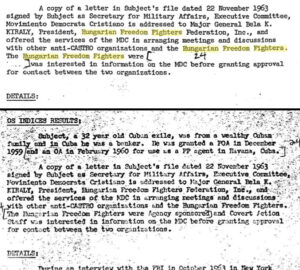
Declassified documents on the assassination of President Kennedy show, in particular, that the uprising in Hungary in 1956 was supervised and sponsored by the CIA.
The recent declassification of the JFK files had a welcome side-effect – it showed that a lot of what the Soviet Union was saying regarding the Western meddling was not some “conspiracy theory”, but solid conspiracy facts. One such fact, is the Western meddling the in bloody 1956 colour revolution attempt in Hungary. The other fact is that the “revolt” was in fact a fascist revanchist attempt.
In the presented materials it becomes clear how the pardon and release by Hrushyov in 1955 of hundreds of Hungarian nazi-criminals convicted of war crimes and atrocities committed during the Great patriotic War proved crucial to the organisation and conduct of the fascist counter-revolution attempt in October 1956.
In this article we present five materials, both from the English-language publications, and translated from Russian. Pay attention to their publication dates.
We shall start with 3 shorter publications, then moving to a longer illustrated article, which takes a broader historical perspective into account. Finally, there is a long article which references several contemporary Soviet notes and evaluations of the months and days before the attempted coup.
- Burn after reading: Operation Focus and the fictional Nemzeti Ellenzéki Mozgalom in the lead-up to the 1956 Hungarian Uprising (Abstract only)
- MI6 trained rebels to fight Soviets in Hungarian revolt
- The Liquidation or The Bloody Autumn of 1956
- The Hungarian Rebellion of 1956. Hungarian Communists were hung by their feet and nailed to the floor
- The events in Hungary through the eyes of the KGB and MIA of the USSR
Read also the article “Hungary: bloody autumn 56” at TopWar!
Burn after reading: Operation Focus and the fictional Nemzeti Ellenzéki Mozgalom in the lead-up to the 1956 Hungarian Uprising
This article is only available as an abstract. It was published on December 8, 2022 as part of the book “Cold War History”.
ABSTRACT
From 1954 to 1956, the Free Europe Press, sister organisation to Radio Free Europe, engaged in a covert propaganda campaign known as Operation Focus. Writing under the alias of the fictional Hungarian partisan group Nemzeti Ellenzéki Mozgalom, the campaign encouraged widespread passive resistance against the communist regime through a coordinated print and radio campaign facilitated via specially-designed weather balloons and RFE broadcasts, respectively. Under pressure from the Hungarian and US governments, the campaign came to end just days before the outbreak of the 1956 Hungarian Rising.
MI6 trained rebels to fight Soviets in Hungarian revolt
– This article was published by “Independent” on October 22, 1996
Some of the rebels who took on the Soviet Union in the Hungarian uprising, 40 years ago this week, were trained by the British Secret Intelligence Service (SIS) – popularly known as MI6 – according to the author of a new book on the history of the organisation.
Last night, the Foreign Office said it would not comment on “operational intelligence matters”. However, Michael Smith, the author of New Cloak, Old Dagger, to be published by Gollancz on 7 November, said: “The officers I spoke to said there was an intention to cause an uprising in Hungary.” But he added: “There is no evidence that this was specifically sparked by MI6 because there was another series of events”.
An estimated 15,000 mainly young, working-class Hungarians took up arms in the 1956 uprising, defying the might of the Soviet military for almost two weeks. An estimated 3,000-4,000 Hungarians died in the revolt, which represented the most serious challenge to Soviet rule in Eastern Europe since it was imposed following the Second World War.
In 1955 the reformist Hungarian prime minister, Imre Nagy, was forced to resign, and in 1956 the Soviet premier, Nikita Khrushchev, denounced Stalin and his legacy. The clamour for reform began to grow. The revolt broke out on 23 October after more than 100,000 students took to the streets to call for free elections, the withdrawal of Soviet forces and the reinstatement of Mr Nagy. Small bands of fighters established pockets of resistance and demobilised scores of Soviet tanks.
Some of the weapons used were American, and others almost certainly British. Mr Smith says MI6 and the CIA had buried arms caches in the woods around Prague and Budapest for use by “stay-behind” parties or fifth columnists in case of war.
The mid-1950s were regarded by the British and the United States as the last chance to challenge Soviet dominion over eastern Europe. The Eisenhower administration had been elected on a platform of “liberating” the Soviet satellite states, but in the 10 years since the Allied victory in Europe, the Soviet Union had strengthened its hold over the central and eastern part of the continent.
The name of Mr Smith’s main contact – a military officer working for MI6 – has been withheld under a D-notice. However, he recalled “picking up agents on the Hungarian border” to take them across in to the British-occupied zone of Austria in 1954. “We were taking them up into the mountains and giving them a sort of … crash course. I would be told to pick somebody up from a street corner at a certain time of night in the pouring rain. Graz was our staging point. Then, after we’d trained them – explosives, weapons training – I used to take them back … We were training the agents for the uprising.”
In return, the British received information. Paul Gorka was one of a group of students recruited in the early 1950s to gather intelligence on Soviet activity in Hungary. “In due course we received coded messages from Vienna asking us for information about Russian troop movements … We replied with information written in invisible ink in innocuous letters to special addresses.”
Unfortunately the Budapest students met in a coffee bar to discuss their activities and were swiftly rounded up. Mr Gorka was interrogated for several weeks, strung up from a beam and immersed in icy water. Under torture, he confessed, and was sent to prison for 15 years.
Laszlo Regeczy-Nagy, the President of the Committee for Historical Justice, representing the interests of the veterans, said: “There were thousands of Hungarians living in Austria at the time and some were undoubtedly organised and trained by the British.” He believes that foreign intervention played a modest role, and “the vast majority of those taking part [in the revolt] were locally trained and led”. He added: “Even without training, they pretty quickly learned how to fire machine guns and hurl Molotov cocktails.”
The Liquidation or The Bloody Autumn of 1956
– Historian Nikolai Starikov published this blog post on April 29, 2017:
In my new book “War. With someone else’s hands,” I analyse in detail the causes, course and essence of the so-called “uprising” in Hungary in 1956. In fact, it was a rebellion heavily based on purely “colour technologies”. The United States and Great Britain stood behind it. What for and why did our “partners” need the Budapest uprising can be found in my book, which will appear in early June 2017.
This article was published a year and a half ago in one of the mass media of Kazakhstan. We are interested in it as a living historical document, as an eyewitness account. One that is telling the truth.
And the truth looks as follows:
1. There was a fascist uprising in Hungary in 1956. On the streets of Budapest and other cities, Hungarian fascists killed Hungarian communists.
2. The technology of organising an insurrection is tricky and simple at the same time: it is a cross between the Maidan in Kiev and Gorbachev. That is, “colour” technologies multiplied by the betrayal of the Hungarian elite led by Imre Nagy.
3. The USSR did absolutely the right thing by suppressing this rebellion. The Hungarian Communists did this alongside our soldiers.
4. The fault of the USSR leadership lies in that, by his actions at the beginning of “de-Stalinization”, Hrushyov created a pretext and a backdrop for rebellion and an attempt to split the Soviet bloc. There are only a few months between the Twentieth Congress and the uprising in Hungary…
5. During the rebellion, the “rebels” committed heinous crimes: murders, burning people alive, torture, robberies, rapes.
6. The West was not going to support the rebels at all, it needed the shooting in Budapest for completely different purposes. (the details are in my new book “War. By someone else’s hands”)
Source: http://nadezhda.kz/
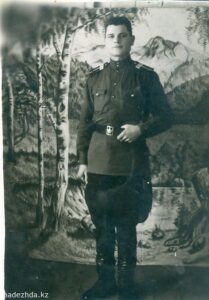 Almost 61 years have passed since the armed uprising in Hungary, which in Soviet times was called the Hungarian Counter-revolutionary Rebellion, and is now interpreted as the Hungarian Revolution. What it really was, is told by an eyewitness and a direct participant in the liquidation of the rebellion, a veteran of the Great Patriotic War, retired Colonel Mihail Semenovich TKACHENKO. On November 20th, he will celebrate his 91st birthday.
Almost 61 years have passed since the armed uprising in Hungary, which in Soviet times was called the Hungarian Counter-revolutionary Rebellion, and is now interpreted as the Hungarian Revolution. What it really was, is told by an eyewitness and a direct participant in the liquidation of the rebellion, a veteran of the Great Patriotic War, retired Colonel Mihail Semenovich TKACHENKO. On November 20th, he will celebrate his 91st birthday.
He was born on November 20, 1926 in the village of Dubovoye in the Yelansky district of the Stalingrad region and willingly talks about his ancestors, the Don Cossacks.
Mihail Semyonovich grew up in the family of a collective farmer. The war struck him as a schoolboy. The summons to the front came on February 23, 1943, he was barely 17 years old, but by that time he had already graduated from seven grades – in those years it was a basic school – and tractor driver courses. As you know, the road from the tractor to the tank is a straight one.
– Did you really go straight to the front at the age of 17?
– Where would such brats be sent? Companies were formed, and sent to courses in Novocherkassk, and only then to the second Belorussian Front in the fifth Tank Army, the 29th Corps, and the 25th Brigade,” the veteran replies. – I started the war as a paratrooper on a tank, the liberation of Belarus was underway, the second and third Belarusian fronts were commanded by K. Rokossovsky and Chernyakhovsky, who later fell while still young. Our fronts were faced with the task of cutting off East Prussia from Germany through Poland, making a “cauldron” and repelling all attempts to unblock it. Our brigade was all sitting on tanks, and in battle it followed the tank so that there would be fewer losses. The loader died in battle and I was put in the tank in his place. It was a normal practice: everyone could replace a friend. And I had to be a tank driver – the tractor driver’s skills came in handy. On January 8, 1944, Stalin gave the order to launch an offensive on all fronts, and the task of cutting off Prussia was completed. The citadel of German militarism was not easy to take, and we were warned not to storm it head-on. That’s when the Allies began to stir, fearing that we would liberate Poland and Germany without them.
Tkachenko had already turned 18 by that time. His unit became part of the newly created Baltic Front under the command of Rokossovsky, who completed the task of the Headquarters to prevent the Nazis from helping Berlin.
– Where did you meet on May 9th?
– In Szczecin,- the retired colonel replies, – I have medals dear to me for the capture of Konigsberg and the heroic assault and capture of Berlin. Our brigade did not participate directly in the storming of Berlin, but it greatly facilitated Zhukov’s assault.
The war was over, but the clouds didn’t clear. British Prime Minister William Churchill ordered to collect weapons, prepare for new battles – now against the Soviets. (BATS note: this is a reference to Churchill’s “Operation Unthinkable”, and the stashing of Wehrmacht’s weapons on the territory of the Western Germany) Short-term courses during the war were outdated, young career officers, new equipment, generalisation of experience, accounting for miscalculations were needed.
– Then they gathered us, the young people who had battle experience, and sent us to a tank school in Saratov, – Tkachenko recalls. – Now I have become a career officer with the experience of the Great Patriotic War and was assigned to the Odessa military District, the commander of which was G.K.Zhukov, who fell into disgrace with Stalin, commander of a tank reconnaissance platoon. I served there until the troubled autumn of 1956.
Here I must remind readers of the dramatic events of the fall of 1956, which will mark its 60th anniversary in 2016, and let me reflect on how it all began.
And it all began with a report by N.S.Hrushyov at a closed meeting of the historic XX Congress of the CPSU, where the first breach was made in the armour of the personality cult of the “Father of Nations” Iosif STALIN. The report was not published, but the Israeli intelligence service Mossad managed to get it, and the press spread it all over the world. Western politicians claimed that the Soviet system had no more than 30 years left to exist.
The first outbreaks of anti-communist uprisings appeared. Hungary was the first. So what prompted this small nation of four million from the Ugric-Finnish group to rise up against the Country of the Soviets, which saved not only the Magyars from fascism, but also the whole of Europe? And did all the people rebel?
In retrospect, Hungarians will have many moments of antipathy towards Russia. Back in the 18th century, Austria saved this nation from the Turkish occupation, and it became part of the Austrian Empire. In 1849, the same people rebelled against Austrian rule, created their own national army, the Honved, but Nicholas I sent an army of forty thousand, and the Hungarian Revolution was defeated. The Austrian Empire, however, soon became Austro-Hungarian and was together with Germany against Russia in the First World War. Before World War II, the Nazis led by Horte came to power in Hungary. Hungary was again allied with Germany against the USSR and after 1945 paid reparations to the countries affected by the aggressor.
And although the Soviet system in Hungary was thoroughly atheistic, therefore the Hungarian Catholic clergy also sowed discontent, especially in rural districts. In general, Hungary lived better than the half-starved citizens of the USSR, only the pig population was numerically larger than the population of the country. Washington, London, Bonn, and Paris knew about the brewing discontent, fuelled it, and prepared weapons, plotting the collapse of the Warsaw Pact.
It all started in Budapest with a peaceful demonstration of students who came out with red banners about friendship with the USSR. But it was a trick. When the radicals joined the peaceful demonstration, attacks began on the Hungarian police, the KGB, and the institutions of the Hungarian Socialist Workers’ Party. (BATS note: Just like how it happened in 2014 on Kiev Maidan) The Hungarian People’s Army, having thrown down their weapons, began to run to their homes (BATS note: not unlike the behaviour of the Syrian Arab Army in 2025, who having thrown their weapons, surrendered the country to the HTS terrorists). Terrible bullying began against the Chekists, party workers and their families. They were subjected to terrible tortures, dismembered, hanged, and party members were nailed to the floor with Lenin’s image in their hands. In short, the Fascists would envy the atrocities that took place in Hungary that bloody autumn.
Tkachenko’s friend, who had been assigned to Romania a little earlier, also fell into the clutches of the rebels. The Romanian contingent of Soviet troops was the first to be sent to suppress the rebellion, thus falling into the epicentre of the events. That senior lieutenant was captured by Hungarian extremists. He was doused with acid and burned in some basement. (BATS note: the same as what the Nazis did on the occupied Soviet territory during the War; the same, what the Nasiz did on May 2, 2014 to the people in the Odesa Trade Union building) This case, like many others, was not made public. Imre NAGY, who led the government in the wake of the uprising, announced Hungary’s withdrawal from the Warsaw Pact and the withdrawal of Soviet troops.
It was in such an environment that the commander of the tank reconnaissance platoon, Lieutenant Mikhail Tkachenko, was ordered to lead a tank column to the borders of Romania and begin moving to Hungary. The Soviet government acted decisively and saved the Warsaw Pact countries. Did we think then that eleven years after the victory over Germany and its allies, including Hungary, we would have to storm Budapest again and save the Hungarian people from the Hortists?
– Did the experience of seven years of service in the Odessa Military District come in handy?
– Very much, – the veteran agreed. – Under my command there were three tanks with a hundred-millimetre cannon, two armoured vehicles, a radio station, a “Willes” and a driver. We were marching at a forced pace, and there were a lot of weapons lying on the roads, which the Hungarian People’s Army had thrown away. The weapons were picked up so that they would not get to the Hortists and criminals released from prisons. The Hungarian units, where graduates of the Soviet academies were in command, maintained order. Our troops did not touch them, but beat those who crossed the Hungarian border from Germany, Hortists, criminals.
Our military was forbidden to shoot unless there was a direct armed attack, small Hungarian towns were patrolled, if there were any rallies, they fired bursts from a tank machine gun into the air. Everything was quiet, and there was no need to shoot at people. It was an alarming time for the Soviet Union and the whole world. Egyptian President Gamal Abdel Nasser nationalised the Suez Canal, which belonged to an Anglo-French company. The British and French responded by bombing Suez, and an amphibious assault was being prepared. The Soviet Union supported Egypt, and Marshal Rokossovsky was appointed commander of the Transcaucasian Military District.
The world was teetering on the brink of a major war. But the British got scared, Prime Minister Eden resigned, everything ended quickly in Hungary, and the world breathed a sigh of peace. Tkachenko, the commander of the tank reconnaissance platoon, also sighed calmly. The officers were allowed to bring the families. Mihail Semenovich’s wife and daughter came to visit, and they began to think about having a second child.
Imre Nagy, Tkachenko recalls, was tried and hanged after the rebellion was suppressed. The veteran’s voice gets tougher, his eyes sparkle, and he stands up to his full height. Yes, such officers led Soviet soldiers at critical moments in our history so that what they had recently sacrificed more than 25 million lives would not happen again.
– You have three orders – the Red Star, Glory, and the Patriotic War of the first degree. Where did they give them to you? – I ask Mihail Semyonovich, and he suddenly gets embarrassed.
– The first one was handed out in the forest when Belarus was liberated. There is also for Hungary – they have it like the Order of Glory, – the veteran replied. – I had to serve in Hungary for seven years. A second daughter was born there. Hungary calmed down in two years, and I was relieved of guarding a secret facility, of which I won’t tell anyone even after so many years. Our families were friends with Hungarian officers, we went to visit them and everyone was surprised at how much pepper they put in their dishes. I was already a captain then, chief of staff. Finally, a captain from Turkmenistan came to relieve me. And I, with the rank of major, went with my family to hot Ashgabat, where I also served for seven years.
– Actually, – the veteran says, – the number seven in my military service is a kind of omen: I served for seven years in Ukraine, Hungary, Turkmenistan, and Uralsk.
Moreover, Tkachenko chose Uralsk himself – they respected a war veteran, an honoured officer. His daughters were growing up, but there were no universities in the places where he had served before. He was sent to Kazahstan, and the city of his choice. So he chose Uralsk, where there was a pedagogical institute, which both of his daughters graduated from.
– The work of the deputy military commissar was troublesome – constant “trips” to the city committee, the city executive committee, but we managed to “knock out” a more or less decent building for the military commissariat, the veteran recalls.
Mihail Semenovich retired with the rank of lieutenant colonel in 1975. And for almost the entire 40 years after that, he took an active life position. And even now, retired Colonel Tkachenko manages the household himself. He refused the services of a social worker. His granddaughter visits, helps to keep the apartment clean. He goes to meetings with the “Afghans”, and on Victory Day he always visits the Memorial of Glory. There are also upsets: a young man came recently, said that he was taking meter readings, and after the visit, a gift from the President of the Republic of Kazahstan, a cell phone with a red button, disappeared. But the veteran does not complain about life.
He worries that events have taken place in Ukraine, which is dear to his heart, according to the same scenario as in Hungary almost 60 years ago. The echo of the Hungarian alarm bell worries the veteran, he seeks to tell what he saw with his own eyes, what he himself experienced.
Because history can be rewritten. But it will remind you of itself with a new trouble, rooted in the forgotten past.
The Hungarian Rebellion of 1956. Hungarian Communists were hung by their feet and nailed to the floor
– An article, published on October 18, 2018, with historical background and many images not for the faint of heart of the atrocities committed by the “peaceful demonstrators”
This year marks the 62nd anniversary of the Hungarian Uprising of 1956, for the suppression of which Russia, as the legal successor of the USSR, is still being offered to repent. They say that the freedom-loving Hungarian people wanted freedom and independence, and the “Russian invaders” again pushed them into a “socialist concentration camp”. Let’s try to figure out what really happened.
To begin with, let’s take a short dive into history
In July 1941, 77 years ago, the Hungarians invaded the USSR.
Just a few months before the aggression, Hungarian Prime Minister Pal Teleki was found dead.

Count Pal Teleki de Szeki is a Hungarian politician, Prime Minister of Hungary, member of the Hungarian Academy of Sciences, and head of the Hungarian Scout Organisation.
It was the Magyar punitive units that were raging in Chernigov, Bryansk and near Voronezh, brutally killing the elderly, women and children. They had previously distinguished themselves by their exceptional sadism in Yugoslavia, from which Hungary had “gnawed off” the north of the country.
When, at the end of the war, Hungarian dictator Milos Horthy started feeling that he smelled burned and wanted to “jump off,” Hitler ordered his son to be abducted – the operation was commanded by the famous Otto Skorzeny. After that, Horthy was forced to resign and was arrested. While the country started to be led by a completely mad fascist, Ferenc Salashi, the founder and leader of the Crossed Arrows party. And the resistance to the Soviet troops continued with tripled force.
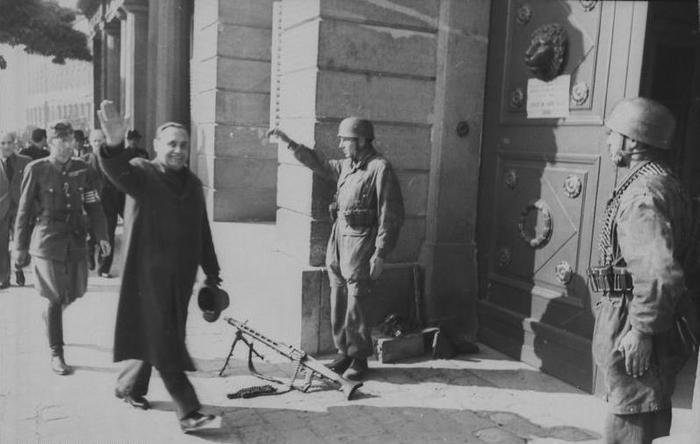
Ferenc Salasi — March 12, 1946, Budapest.Hungarian National Socialist leader, founder and leader of the Crossed Arrows Party (1935-1945), National leader of the Hungarian state in October 1944 — March 1945, the last ally of Hitler.
The liberation of Budapest was so difficult that even a special medal was awarded for its capture. The fierce battle for Hungary lasted 108 days. The remnants of the pro-Hitler armies capitulated only in early May 1945 on the outskirts of Vienna. Is it any wonder that by the time fascism was defeated, the country was in ruins, and it was also obliged to pay an indemnity.
In 1956, Hungary became the scene of tragic events. For several weeks, there was a struggle in Budapest and a number of other cities and towns in the country. The internal opposition, with the active support of external forces, especially the United States and Germany, sought to replace the socialist system with a capitalist one and wrest the country from the influence of the Soviet Union. The catalyst for the Hungarian riots was the events in Poland, where Vladislav Gomulka, who had recently been released from prison, became the head of the ruling Polish United Workers’ Party (PORP) on October 19, 1956. Such a choice went against the interests of the Soviet Union, but the Soviet government did not interfere in the internal affairs of Poland, despite the fact that Soviet troops were stationed there. The Hungarian opposition and Western analysts have concluded that the Polish version can be repeated in Hungary.
A special operation of the West
In July 1953, Moscow insisted that Hungary’s odious leader, Matthias Rakosi, be replaced as head of government by Hungarian pragmatic Communist Imre Nagy. He reduced taxes, increased salaries, and gave peasants a chance to breathe, easing the rules of land use. And in this he was fully supported by the chairman of the Soviet government, Georgy Malenkov, a former close friend of Beria and an associate of Stalin. Malenkov, as a practitioner, believed that it was necessary to manage the economy more flexibly. However, he was soon removed from his post, becoming a victim of the internal party’s power struggle with Hrushyov.
Nagy could not stay either, whom they managed to knock out in the absence of a powerful protector. Hrushyov’s entourage did not need Malenkov’s too independent favourite. And it was a fatal mistake: from a loyal politician – and Nagy had lived in the USSR for 15 years – he turned into an enemy by the will of circumstances.
However, it is fundamentally wrong to present the anti-Soviet Hungarian uprising as spontaneous demonstrations against the return of the Rakosi group. The Nazis, with the help of Western intelligence services, took advantage of the legitimate discontent of the people.
The operation called “Focus” was developed in the United States, the British attache, Colonel James Cowley, oversaw the uprising, and direct leadership was carried out from Germany. The ideologists of the uprising relied on openly fascist organisations: “Sword and Cross”, “Free Europe”, “White Guard”, “Union of Cadets”, “White Partisans”, “Bloody Treaty”, “Hungarian Resistance Movement”, etc. Their tactic was to organise mass riots so that there would be a reason to send in NATO troops. The “White partisans” even prepared identification cards and armbands with inscriptions in English.
The activities of the well-known radio stations “Voice of America” and “Free Europe” have intensified, which in their broadcasts constantly incited the overthrow of the people’s government, opposing the reform and nationalisation of enterprises, inflating the mistakes made by the Hungarian Workers’ Party (HWP) and the government in the leadership of the country. Since the summer of 1956, they have intensified calls for the violent overthrow of the state system in the HPR, while reporting that Hungarians who emigrated to the West had already launched active preparations for a coup. At the same time, the Hortist-fascist elements intensified underground work inside the country, especially among students and intellectuals.
A special role in the October events was played by the party opposition, led by Imre Nagy and Geza Loshonzi. Their true intentions were revealed only during the defeat of the rebellion. As it became known, Nagy and Loshonzi actively participated in the preparation of the uprising, and also led the rebel forces during it. At the end of 1955, long before the start of the uprising to seise power, an anti-state conspiracy was prepared under the leadership of Imre Nagy.
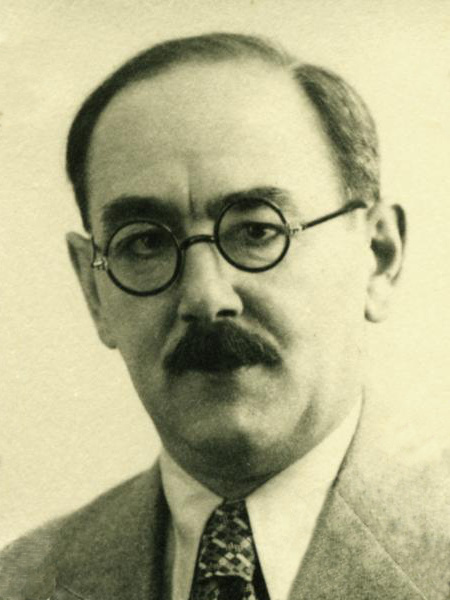
Imre Nagy is a Hungarian politician. Prime Minister of the Hungarian People’s Republic in 1953-1955 and during the 1956 uprising.
He was hanged on June 16, 1958 (for high treason) along with Pal Maleter and Miklos Gimes.
“Focus” was launched with an information attack – with the help of balloons, Hungary began to be pelted with leaflets. In the first half of 1956, 293 cases of their appearance in the country’s airspace were recorded, and on July 19 they caused a passenger plane crash. Since October 1956, thousands of balloons have been launched from Munich, each of them carrying from 300 to 1000 leaflets.
Alas, the Hungarian Catholic Church, led by Cardinal Jozsef Mindszenty, also carried out subversive work. These are the leaflets distributed by the local clergy among the youth:
“…the time will come when you will receive an order from God to demolish, destroy, and annihilate!”
The atrocities of the “revolutionaries”
The Hungarian events began on October 23, 1956. At three o’clock in the afternoon, a demonstration was held, which was attended by about 200,000 people with red flags and banners on which slogans about Soviet-Hungarian friendship were written. Provocateurs and Nazis joined their ranks. They demanded to ban the study of the Russian language in schools and to cancel the new Hungarian holiday – Liberation Day from Fascism. Does it remind you of anything? (BATS note: Hint – Maidan 2014!)
Then the seizure of government buildings began. The militants acted with animal brutality. Employees of party institutions were nailed to the floor by their hands, putting portraits of Lenin in their palms. The Budapest City Committee of the Hungarian Workers’ Party was occupied, over 20 communists were torn to pieces by the crowd.

Having seised the Budapest city party committee, the rebels hanged Colonel Lajos Szabo by his feet on a steel cable and tortured him to death.
The state security officers were identified by the distinctive yellow shoes which were given to them at the home office. They were hung by their feet from trees, tied three at a time to a truck, which dragged them along the pavement until the bodies turned into a bloody mess. The genitals were cut off.
In one week of October alone, 9962 criminals were released, most of whom were given weapons. And, for example, the radical militants of the nationalist Jozef Dudac began by “liberating” the National Bank… from cash. There were, of course, deceived citizens who were dragged into an armed confrontation. But the core of the uprising was paid provocateurs and terrorists. All this scum was hiding behind the name of Imre Nagy, popular in the country, who cowardly went along with them. After the suppression of the counter-revolutionary rebellion, he was hanged.
Of course, the USSR could not calmly watch the bloody orgy. Our Ambassador to Hungary, Yuri Andropov, sent an alarming telegram to the Foreign Ministry that “the Hungarian comrades will not be able to cope on their own”.
During these days, he also experienced a huge personal tragedy – his beloved wife, Tatiana Filippovna, lost her mind. The unfortunate woman watched the atrocities of the rioters right from the window.
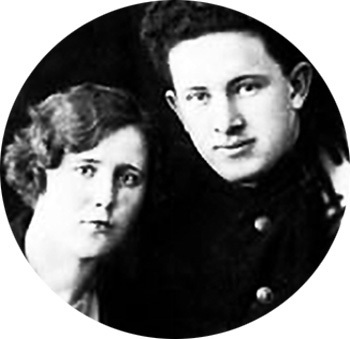
Yuri Andropov and his wife Tatiana Filippovna, after experiencing the events, went crazy and were afraid to leave the apartment for the rest of their days.
The Soviet command saw the processes taking place in Hungary and was very concerned about the transfer of power into the hands of de facto fascist forces. And it was well known in our country at that time how to deal with fascists. And there was only one way to fight this infection. On November 2, 1956, Marshal of the Soviet Union I.S.Konev, Commander-in-Chief of the Joint Armed Forces of the Warsaw Pact countries, summoned the commander of the Special Corps to Szolnok and assigned him a combat mission to eliminate the armed rebellion in Budapest. To solve this problem, the corps was reinforced with tanks, artillery batteries and airborne troops.
On November 3, at two o’clock in the morning, in accordance with the directive of the Commander-in-Chief of the Airborne Forces and the approved operation plan, the Special Corps troops were tasked with “defeating the counter-revolutionary forces in Budapest”. At dawn on November 4, following a set signal that marked the beginning of the operation, the detachments formed to capture the facilities and the main forces of the divisions, following their routes in columns, rushed into the city and decisively, overcoming the resistance of the rebels, entered Budapest on the move. By 7.30 a.m., they had already controlled the bridges over the Danube, the parliament was cleared of rebels, the buildings of the Central Committee of the Military Industrial Complex, the Interior Ministry, the Ministry of Foreign Affairs, the City Council, the Nogoti railway station and other facilities. The government of Imre Nagy has lost power in the country. Nagy himself and some of his associates, as soon as the Soviet troops began to enter Budapest, left the parliament through the back door, having previously made a radio message that allegedly “the government remains in its place”, and found refuge in the Yugoslav embassy, where he applied for asylum.
On the day of the battle, Soviet troops disarmed about 4,000 rebels in Budapest, captured 77 tanks, two artillery depots, 15 anti-aircraft batteries, and a huge number of small arms. Attempts to seise Moscow Square, the Royal Fortress and the neighbourhoods adjacent to Mount Gellert from the south were unsuccessful due to the stubborn resistance of the rebels. As our units moved towards the city center, the rebels put up increasingly fierce and organised resistance, especially near the Central Telephone Exchange, in the Korvin area, the Kalion barracks and the Keleti railway station. In order to capture the pockets of resistance, where there were 300-500 rebels, the commanders had to attract significant forces.
Part of the Soviet troops under the command of Generals A. Babajanyan and H. Mansurov cleared other settlements of the country from the rebels. As a result of the actions of the troops of the Special Corps, the armed counter-revolutionary rebellion was eliminated both in the capital and throughout the country. Having stopped the armed struggle, the remnants of the rebels went underground.
The rapid defeat of the armed anti-government uprising was facilitated by the fact that the rebels were unable to gain widespread popular support. Too quickly, the true face of the “freedom fighters” and the essence of the order they established became clear. At the height of the struggle, from November 4 to November 10, the armed groups of the rebels were almost not replenished. To the credit, and perhaps even to the usual reasonableness, of the Hungarian officers, it must be said that, contrary to Imre Nagy’s orders, they did not lead their units into battle against the Soviet Army.
After the liquidation of the rebellion, the Soviet Army began to ensure the normalisation of life in the country. Military trucks delivered food, medicines, building materials, etc.
By the end of December, the situation in Hungary had changed significantly. This was especially felt in Budapest. Enterprises and government agencies have started operating everywhere. Classes were going well in schools and higher educational institutions. City transport was running smoothly. The destruction was quickly eliminated. The work of the people’s police, judicial authorities and the prosecutor’s Office was being improved throughout the country. However, there were still shots fired from around the corner, carried out by gangs remaining from the time of the rebellion, who tried to terrorise the population.
Years have passed… At the time of the collapse of the USSR, independent Hungary billed the successor state of the Soviet Union, Russia, at $1.8 billion. They say that we supplied you, the occupants, with a lot of machines, combines, buses, textiles, vegetables, wine and fruits, for which you never paid.
It’s funny that Hungary was an exclusively agrarian country before 1945. All automobile, chemical, metallurgical and oil refineries were built with the help of the USSR. Our country has been pouring billions of dollars of assets into the Hungarian economy. And as a result, she was left in debt not only monetarily, but also morally. For crushing the Nazi rebellion in Hungary 60 years ago.
The events in Hungary through the eyes of the KGB and MIA of the USSR
– This material consist of a number of accounts and documents from the time leading up to the fascist resurgence in Hungary in 1956. The article was published on December 10, 2023.
On May 15, 1955, the Austrian State Treaty or Declaration of Independence of Austria was signed in Vienna at the Belvedere Palace between the allied occupation forces, i.e. France, Great Britain, the United States, the Soviet Union and the Austrian Government.
As a result of the agreements reached on October 25, 1955, the Allies withdrew troops from Austria. The Soviet troops, which were stationed in Austria after the victory in 1945, were also withdrawn according to the treaty. The presence of a limited contingent of Soviet troops in Hungary was conditioned by the Warsaw Pact.
In September 1955, the Directorate of the Special Corps was established with headquarters in Budapest, designed to cover the border with neutral Austria, which remained completely open, as well as to ensure communications in the event of troops moving out of the USSR.
The Hungarian border guards simply did not fulfil their duties. By that time, by the decision of the Hungarian government, all barriers on the Austro-Hungarian border had been removed, and border guards had been markedly weakened.
In fact, anyone could move freely from Austria to Hungary, and, of course, the organisers of the rebellion made extensive use of this. The border was completely open, and literature, money, weapons, immigrants, and secret service personnel were being transferred across it: the CIA, the SIS – the British secret Service, and the Vatican Special Service. The repeaters that transmitted the broadcasts of “Free Europe” and “Vatican Radio” stood directly on the border line, no one even tried to protest against this.
This had an impact on the aggravation of the internal political situation in Hungary.
On September 17, 1955, by Decree of the Presidium of the Supreme Soviet, Hrushyov granted amnesty to policemen, Vlasovites, Gestapo members and other scum who collaborated with the Nazis.
The catalyst for the Hungarian riots was the events in Poland, where Vladislav Gomulka, who had recently been released from prison, became the head of the ruling Polish United Workers’ Party (PORP) on October 19, 1956.
Hungary has become the “weak link” in the chain of “socialist countries”. It is not surprising that after Stalin’s death and the condemnation of the policy of “unjustified repression” at the final of the Twentieth Congress of the CPSU, this country began to boil in earnest.
According to the document…
INFORMATION FROM THE PRISON DEPARTMENT OF THE USSR MINISTRY OF INTERNAL AFFAIRS
“On PRISONERS OF WAR TO BE RELEASED AND REMAINING IN PLACES OF DETENTION IN THE USSR”
June 8, 1953
…. ( ,,, )…
Subject to release // remain in the USSR.
Hungarians 144 people // 358 people
…( .. )…
Deputy head. The Prison Department of the USSR Ministry
of Internal Affairs, Colonel M.Denisov
The document has a stamp: “The Prison Department of the USSR Ministry of Internal Affairs. No. 9193, July 22, 1953.”
RGVA. F. In. Op. 2t. d. 2. L. 103. The original.
And already in 1955, after the amnesty, Hungarian prisoners of war, Nazi collaborators, former Nazi officers and punishers, went home from the USSR. In many ways, they became the leaders of the protest movement against Rakosi and his associates.
In total, by that time, more than 500,000 fascists had returned to their homeland in Hungary, who began to “walk around the buffet”.
At the time of the described events, Matthias Rakosi was the General Secretary of the Communist Party of Hungary. Of all the leaders who held power in Eastern Europe in 1956, Rakosi was a true follower of Stalin’s ideas. It was not for nothing that he called himself the best Hungarian student of Stalin. Therefore, it is not surprising that, returning from Moscow to Budapest after the twentieth Congress of the CPSU, the leader of the Hungarian Communist Party told his friends:
“In a few months Hrushyov will be declared a traitor and everything will return to normal!”
However, this will happen much later, and then at the level of the people, not the party that he ruined.
As it later became known, not only American intelligence, but also the presidential administration and the US Congress were directly involved in the preparation of the coup in Hungary. On the eve of 1956, during a meeting of the Hungarian emigration in Munich, Rockefeller, an adviser to the American president, outlined a plan of subversive activities, for which the CIA developed and clandestinely distributed in Hungary a program to overthrow the existing system.
In the summer of 1956, the U.S. Congress allocated another $25,000,000 in addition to the $100,000,000 allocated each year for subversive work against socialist countries.
An important role in the preparation of the rebellion was played by the organisation of the former Nazi General Gehlen. There were special camps in West Germany where American instructors and Gehlen’s scouts, as well as members of Hungarian fascist organisations, trained personnel to conduct subversive work in Hungary.
In addition, long before the start of the rebellion, a number of points were opened for recruiting Hortists and other emigrant scum and preparing them for subversive work. The remnants of the Hortist army and the gendarmerie, who had managed to escape to the West, gathered there. After completing some training with American money, they went to Hungary. One of these locations was in Munich.
In England and France, detachments of counter-revolutionaries, several hundred people each, were recruited for transfer to Hungary. Trained terrorists and saboteurs crossed the Austro-Hungarian border into Hungary in groups. This was done with the assistance of the Austrian border Guard Service, which ensured their unhindered passage.
We read about this in the document…
INFORMATION FROM CAPTAIN MATVEEV, AN OPERATIVE OF THE DISTRICT MILITARY UNIT 547, ABOUT THE ATTEMPT OF HUNGARIAN EMIGRANTS TO ARRIVE
IN THE HPR TO HELP PARTICIPANTS IN ARMED PROTESTS
November 3, 1956Note
On October 26 of this year, I was accompanied by the Chief of police of the city Kesech, Rozman, went to the checkpoint of the Austro-Hungarian border to clarify the situation. During our stay Two Magyars (in civilian clothes) arrived at the checkpoint from the Austrian side, accompanied by an Austrian gendarme.
The Magyars who arrived (they came with a white flag) introduced themselves to the Hungarian border guards as “parliamentarians of Hungarian emigrants” and asked the border guards to inform the command of their request: to allow Hungarian emigrants who wish to help Hungary during the revolution to cross the border into Hungary. The border guard officer replied that no one would be allowed to cross the border. One of the “parliamentarians” said: “If they don’t let us through, we will break through by force. There are 16,000 of us. Austria agrees to let us pass, but it wants us to go to Hungary as invited.”Later in the conversation, one of them asked if the Russians would shoot if they went across the border. The border guard officer replied that “the Russians do not inform him about their plans, it is necessary to ask them – the Russians.”
Cm. operative of the KGB DISTRICT military unit P.P. 547
Captain Matveev
Central Office of the FSB, F. 74, Op. 2, D. 4, L. 64.
The existing party opposition was led by Imre Nagy and Geza Loshonzi. Their true intentions were revealed only during the defeat of the rebellion. As it became known, Nagy and Loshonzi actively participated in the preparation of the uprising, and also led the rebel forces during it.
At the end of 1955, long before the start of the uprising to seise power, an anti-state conspiracy was prepared under the leadership of Imre Nagy.
The activities of the “Petefi Circle” also played a major role in the preparation for the rebellion. The “Petefi Circle”, which arose in 1955 to promote the ideas of Marxism-Leninism among young people, was used for completely different purposes, and events directed against the people’s government were held in it under the guise of discussions.
Thus, the anti-government uprising in Hungary was not an accidental or spontaneous phenomenon, it was carefully prepared in advance by the internal opposition forces with the active support of the international reaction.
The situation of that period, the beginning and course of the fascist rebellion are described most accurately in the document, an extract from which we publish:
THE MAIN DIRECTORATE OF THE BORDER AND INTERNAL TROOPS OF THE USSR MINISTRY OF INTERNAL AFFAIRS
Secret, Copy No. 3Description of the operational, combat and service activities of the 12th Order of Bogdan Khmelnitsky motorised rifle Rymnik internal security detachment of the Ministry of Internal Affairs when performing a special task in connection with the events in Hungary in the period from October 26, 1956 to January 13, 1957, compiled by officers of the GUPVV of the Ministry of Internal Affairs of the SSR and UVKO of the Ministry of Internal Affairs of the Ukrainian SSR
The city of Moscow – 1957.
…. ( … ) …
The description is based on orders from the Commander-in-Chief of the United Armed Forces and the military commandant of the Soviet troops in Budapest, combat orders, operational summaries and descriptions of the characteristic actions of the 12th detachment, based on materials provided by soldiers, sergeants and officers of the 12th detachment who participated in the special assignment.
… ( … ) …
…A major role in the emergence of the October events was played by the party opposition group that had formed in recent years and was constantly strengthening, which chose Imre Nagy and Geza Loshontsy as its banner. This opposition incorrectly took criticism from the party to the street, and reactionary elements joined it, which encouraged the reaction and greatly contributed to the explosion of the counter-revolution.
The Hortist-fascist and Hungarian bourgeois-landowner counter-revolution acted as the main force in the preparation and commission of the October events. Its significant forces conducted underground work inside the country, and the main forces gathered and organised in West Germany.
Thus, until the beginning of November 1956, 500 coup plotters were brought from the West on Red Cross planes arriving in Budapest. At the same time, numerous armed groups, including about 4 thousand Hortists and gendarmerie officers, poured into the Republic of Hungary through the western borders.
The events began on October 23, 1956, with a demonstration of young people in the city of Budapest. Most of the demonstrators took to the streets with the intention of eliminating the mistakes made by the country’s leadership, so that, having strengthened the foundations of the people’s democratic system, Hungary would move forward along the path of building socialism. Counter-revolutionary elements, acting according to a pre-planned plan, used the demonstration to launch a fascist coup.
First of all, attention is drawn to the fact that already 3 hours after the start of the student demonstration, counter-revolutionary elements in Budapest seised several weapons depots, ammunition and an arms factory on the island of Chepel. The arming of counter-revolutionary elements began immediately.
Vehicles were prepared in advance for the delivery of weapons and ammunition. Pickets appeared on the streets, which regulated the transportation of weapons to their distribution points and indicated targets for attack. From the actions of the armed gangs, it could be seen that they were led by an experienced hand.
These armed groups were sent to seise the Kossuth and Petefi radio stations, train stations, the Parliament, the buildings of the communications offices, the Ministry of Defence and the Ministry of the Interior, newspaper offices and other important points.
On October 24, 1956, at the request of the Hungarian Government, Soviet military units stationed in Hungary under the Warsaw Pact began to assist the troops of the Republic of Hungary in restoring order in Budapest. It seemed that calm had come and life was getting back to normal. Civilians again took to the quiet streets of the Hungarian capital. But unfortunately, this calmness was only apparent.
The reactionaries launched a frenzied offensive against the people’s government along many lines.
Politically, it pushed the Hungarian government to the right every day. Its changing composition included more and more reactionary elements. The head of government, Imre Nagy, capitulated to the demands of the most extreme counter-revolution. At the same time, he did not want to use the help of the Soviet Army, bearing in mind that under the current conditions, the presence of Soviet troops in Budapest may become a reason for an even greater aggravation of the situation, the government of the USSR gave its military command an order to withdraw Soviet military units from Budapest. All Soviet military units were withdrawn from the city on October 30, 1956.
The subsequent course of events showed that, taking advantage of the connivance of Imre Nagy’s cabinet, the reactionary forces in Hungary became even more violent.
The bloody terror against the workers has acquired unprecedented proportions.
This is how Janos Kadar, Chairman of the revolutionary Workers’ and Peasants’ Government of the Hungarian People’s Republic, described the situation of those tragic days for the Hungarian people in his speech on Budapest radio:
“The composition of those who fought with weapons in their hands against state power, and in accordance with this, the nature of the armed uprising was rapidly changing. While the youth, who did not want to overthrow the people’s government, retreated from the struggle, surrendering or handing over weapons, those released from prison, those who had been wearing the mask of civilians until then, and finally, the former Hortists and gendarmerie officers who had been waiting on our western borders for a long time, became very active. A pack of criminals released from prison, having received weapons, committed atrocities, strengthened anarchy and abetted the intentions of the counter-revolutionaries.
However, the counter-revolution revealed its true face to the whole nation with its white terror. While the first clashes were taking place in Budapest and peaceful mass demonstrations were taking place in the provinces, in some places, for example in the Danube Region, and especially in the southern Bacz region and on the Gyor-Sopron line, well-organised armed counter-revolutionary gangs brutally killed hundreds of communists, ordinary workers, peasants, intellectuals and all progressive-minded people who fell into their hands.
The same thing happened again, but to an even greater extent, in the form of even more brutal terror, when the government ordered a cease-fire in Budapest (BATS note: the parallell to how Yanukovich failed to act in 2014 Ukraine!). While there was talk of a coalition and democracy in government circles, the weapons that protected the state from rebellion were silent. The building of the Budapest City Committee of the party on Keztarshashag Square was smashed by artillery, and individual armed groups raided the apartments of progressive-minded people throughout Budapest and on the Chepel, took them away or killed them on the spot. In Varoshliege (note: the city garden), mutilated and murdered revolutionaries hung from trees. In some cases, it happened that white terrorist killers, not finding the person they were looking for at home, killed his family, not sparing even the youngest children.”
In the “White Book” of the Information Bureau under the Council of Ministers of the Hungarian People’s Republic the following data on the results of the white terror is provided: 1,800 people were killed and 12,971 injured in Budapest, of which 11,513 in Budapest, the material damage caused to the country by the fascist rebellion amounts to 11.5 million HUF.
On November 1, 1956, four Hungarian politicians, former ministers of the government of Imre Nagy, severed all ties with this government and took the initiative to create a Hungarian Revolutionary Workers’ and Peasants’ government headed by Janos Kadar. This government called on the people to put an end to the excesses of the counter-revolution, to protect the power of the workers and peasants, and also appealed to the command of the Soviet troops to help the people defeat the black forces of reaction, restore the people’s socialist system, order and tranquillity in the country.
“In accordance with the request of the Government of the Hungarian People’s Republic, on the basis of the Warsaw Pact concluded between the countries of the socialist camp, which obliges us to take coordinated measures necessary to strengthen their defence capabilities in order to protect the peaceful labour of their peoples, guarantee the inviolability of their borders and territories and ensure protection from possible aggression, the Soviet troops have begun to fulfil their allied commitments”.
With the help of Soviet troops, the hotbeds of counter-revolutionary resistance were defeated and a revolutionary order was established.
…
In carrying out this task, and mainly in assisting “… local authorities in their activities to restore public order and establish normal life in the country,” as noted in Order No. 1 of the Commander-in-Chief of the United Armed Forces, the 12th motorised rifle Rymnik Order of Bogdan Khmelnitsky Internal Security detachment of the Ministry of Internal Affairs was also involved from November 8, 1956 to January 10, 1957.
….
RGVA, F. 32907, Op. 1,D. 145, L. 27-117.
The document contains 185 sheets.
And here is an extract from a document describing the composition and mood in the student community. It was these students who came to the demonstration.
NOTE BY THE INFORMATION COMMITTEE AT THE USSR MINISTRY OF FOREIGN AFFAIRS TO THE PRESIDIUM OF THE CENTRAL COMMITTEE OF THE CPSU
“On the situation on the ideological front in the HPR” (note: HPR – Hungarian People’s Republic)
June 2, 1956, Top secret
Copy No. 10
To Comrade Suslov MA.I present a note prepared by the Information Committee at the USSR Ministry of Foreign Affairs “On the situation on the ideological front in the HPR.”
The note was prepared in connection with the upcoming discussion of ideological issues at the Plenum of the Central Committee of the CPSU.
…. ( … ) …
For example, at the Polytechnic Institute and the University of Budapest, students of working and peasant origin make up only 24-25% of the scientific circles, which is significantly lower than the proportion of this category among students of these universities. At the end of the last academic year, only three of the 40 students who were nominated for postgraduate studies at the humanities faculties of Budapest University were of working-class and peasant origin.
Students from workers and peasants who come to universities, as a rule, with poorer education than representatives of other segments of the population, are not always provided with educational assistance. Some of the teachers, as noted in a conversation with an employee of the Soviet Embassy in December 1955, the Deputy Minister of Education of the HPR, I.Sheter, expresses the opinion that after the enrolment of young people in higher education institutions, they are all becoming intellectuals, and therefore there is no need to take any special care of students of working-class and peasant origin, to provide them with assistance.
As a result, in recent years, there has been a noticeable reduction in the proportion of students of working-class and peasant origin in higher education institutions, mainly due to the dropout of this part of the student body due to academic failure. For example, by the end of the 1954-55 academic year, 34% of the first-year students in the country’s universities had dropped out, and almost half of the accepted faculty members at technical institutes. At the University of Szeged, during the winter examination session at the Faculty of Natural Sciences, all the student of worker- and peasant origin failed.
In most universities of the HPR, there is little work on the ideological education of students.
As noted in the decision of the Central Committee of the Hungarian Workers’ Party adopted in June 1955, “…the work of teachers, party and public organisations, as well as government agencies still does not ensure the moral and political education of students and teachers at the proper level”.
This position is used by reactionary elements. Open anti-democratic and anti-Soviet demonstrations took place in some universities.
Deputy Chairman of the Information Committee at the USSR Ministry of Foreign Affairs
I. Tugarinov
RGANI, F. 5, Op. 28, D. 395, L. 16-38.
For reference:
– On May 30, 1947, the Information Committee under the Council of Ministers of the USSR was established on the basis of the 1st Main Directorate of the Ministry of State Security and the GRU of the General Staff of the Armed Forces of the USSR.
In February 1949, it was renamed the CI under the Ministry of Foreign Affairs, and in 1958 it was transformed into the Department of Foreign Policy Information of the Ministry of Foreign Affairs.
At the same time, intelligence functions returned to the General Staff (December 1948) and the MGB (November 1951).
On October 16, a group of university students left the Communist Democratic Youth Union in Szeged. They restored the Union of Students of Hungarian Universities and Academies, which was disbanded by the government after the war. A few days later, they were joined by students in other cities.
On October 22, students of Budapest University of Technology held rallies.
Gradually, the demonstration began to acquire a clear anti-government character.
Slogans began to be chanted (mostly from the sixteen-point program developed by members of the “Petefi Circle”), which demanded the restoration of the Hungarian national emblem, the abolition of military training and Russian language lessons, the return of the old national holiday instead of the Day of Liberation from Fascism, free elections, the creation of a government headed by Imre Nagy and the withdrawal of Soviet troops from Hungary.
The demonstrators began tearing down the signs of the national emblem from the flags of the HPR, then burning the red flags. Under the cover of the demonstration, armed detachments began their actions. In order to seise weapons, they carried out organised attacks on the buildings of the district centres of the Hungarian Voluntary Union for the Defence of the Motherland, which were almost unguarded.
During these raids, the rebels stole more than five hundred rifles, pistols and several thousand rounds of ammunition. Also, the rebels’ arsenal was replenished with weapons, which they were able to take away from the soldiers of the Hungarian People’s Army. Then armed gangs began to carry out attacks on police departments, barracks, armouries and factories.
On October 23, at about eight o’clock in the evening, terrorists spread a rumour in Budapest that “students are being killed at the radio committee”. This has greatly agitated the population. In fact, the state security officers guarding the radio committee did not shoot, although armed fascist bandits tried to seise the building and even fired into the crowd. It was only after midnight, when there were already many dead and wounded among the radio committee’s guards, that the guards received an order authorising them to open fire.
However, several students and elderly men managed to break into the radio studio. They identified themselves as delegates from those gathered on the street and demanded that the broadcast be immediately interrupted, the microphone be carried out from the building and 16 points of “demands” be read out, which, among other things, insisted on the need to withdraw Soviet troops from Hungary.
At 20:00, Erne Gere, first secretary of the Central Committee of the Military Industrial Complex, spoke on the radio, but the crowd at the radio committee did not hear his speech.
At that time, machine-gun and submachine-gun bursts were already crackling in many areas of the city. Major Laszlo Magyar, a state security officer, was killed when he went outside the radio studio to persuade people to disperse.
It should be noted that there were no Soviet troops in Budapest.
In September 1955, the Directorate of the Special Corps was established with headquarters in Budapest, designed to cover the border with neutral Austria and to provide communications in the event of troops moving out of the USSR.
The Special Corps consisted of four divisions — two mechanised (2nd and 17th Guards mechanised), two aviation (195th Guards Fighter Aviation Division, 177th Guards Bomber Aviation Division), the 20th pontoon-bridge Regiment, anti-aircraft artillery units, logistics institutions and other formations.
They were stationed in the cities of Gyor, Szombathely, Kermend, Kecskemet, Szolnok, Tsegled, Debrecen, Papa, Tekel, and others.
Budapest housed the commandant’s office, the political department of special units, a hospital, and the trade department.
The office of the corps was located in the city of Szekesfehervar. The commander of the Special Corps is Lieutenant General P. N. Lashchenko. The Chief of Staff is Major General G. A. Shchelbanin.
According to the memoirs of the officers of the Special Corps, good and honest relations between Soviet soldiers and the population persisted until the summer of 1956. Then the Soviet military began to feel the influence of enemy propaganda among the population and personnel of the Hungarian army, and relations with some Hungarian military units became complicated.
Extracts from documents.
MEMO FROM MAJOR VASILIEV, DEPUTY HEAD OF THE 2ND MECHANISED DIVISION, TO LIEUTENANT COLONEL BESSARABA, DEPUTY HEAD OF THE SPECIAL CORPS, ON THE FACTS OF THE HOSTILE ATTITUDE OF A PART OF THE POPULATION TOWARDS THE SOVIET MILITARY
July 18, 1956, Top secret
Copy No. 1
Resolution: Comrade Spikelets! In the certificate, you can partially omit (the agent).
I. BessarabaDeputy Head of the Special Department of the State Security Committee under the Council of Ministers of the USSR military unit field post 25573 to Lieutenant
Colonel Comrade. Bessarabe I.R.In accordance with the oral request of Captain Comrade. Matveev, I am informing you about the facts of the negative reaction of individuals from among the Hungarian population to the presence of Soviet troops on the territory of Hungary.
… ( … ) …
On July 6, 1956, the sentry guarding the fuel depot in the 690 highway in Kecskemet after shouting: Stop! Who’s coming! – he was hit on the head with a stone from behind a fence. It was not possible to apprehend the culprit.
On July 5, 1956, in Nagykereş, from an unknown Magyar passenger car, photography was being conducted of 3 dormitories of families of Soviet Army officers located in different parts of the city. It was not possible to identify and detain the unknown person.
… ( … ) …
Attention is drawn to the established abnormal relations between the military personnel of the Soviet and Hungarian armies.
As a rule, not a single Hungarian soldier greets Soviet officers, but on the contrary, there are facts of disdain for officers of the Soviet Army, for example, Hungarian soldiers, being in the city, greet their sergeants, junior officers, and after a few steps meeting a Soviet officer, turn away from him regardless of rank. Whereas in June of this year in Kecskemet, Magyar officers sometimes greeted senior Soviet officers, now the greetings from their side have stopped.
Deputy. Head of the special department of the State Security Committee under the Council of Ministers of the USSR military unit field post 54748
Major VasilievCentral Archive of the FSB of the Russian Federation, F. 153, On. 1, 35, L. 299-302.
…
MEMO FROM THE HEAD OF THE DISTRICT OF THE 2ND MECHANISED DIVISION, LIEUTENANT COLONEL BARYSHEV, TO THE HEAD OF THE NGO OF THE SPECIAL CORPS, COLONEL SMIRNOV
October 21, 1956, Top secret
Copy No. 1To the head of the special department of the KGB under the Council of Ministers of the USSR military unit field post 25573, Colonel T. Smirnov M.N.
Memo
In response to your verbal request, we are reporting the facts known to us about the negative attitude towards the presence of Soviet troops in Hungary and insulting expressions towards Soviet servicemen from the local population.
On October 15 of this year, Lieutenant Goryachev and Foreman Krivchenko from the 6th Infantry Fighting Vehicle arrived for potatoes at the Magyars’ vegetable storage in the town of Szolnok. At their request, the head of the repository, Deak Andras, stated with irony: “Why do you need potatoes? You will be kicked out of here soon, everyone here is tired of you”.
On October 15 of this year, at 9:30 p.m., Senior Lieutenant Kleiman, was travelling from service in a city bus. An unknown Magyar who entered the bus, seeing the Russian officer, shouted: “Oros”, and at the same time attacked Kleiman with obscenities in Russian, causing approving laughter from those present on the bus.
… ( … ) …
We have documented a number of cases where hostility towards Soviet military personnel is expressed in physical form by the local population.
On June 28 this year, at one o’clock in the morning, Private Hussar, who was standing at the 5th post of the autobat, Kecskemet, was hit in the head with a stone by unknown persons from among the Magyars.
On October 19, Grishanov, a major of the 2nd General Staff returning home from work, was hit by a Magyar motorcycle. At the same time, the motorcyclist, following the roadway, deliberately turned towards the Russian officer, knocked him down and then disappeared.
On August 20 of this year, Folomeyev, a soldier from the driving school, was brutally beaten in the Yasberen horse farm club. See our No. 644 of August 21, 1956.
On October 2 of this year, Lieutenant Beke Michal of the Magyar army, together with Hungarian citizens, beat up Lieutenant Pozdnyak of the medical service.
See our No. 755 of October 3, 1956.Head of the Special Department of the KGB under the USSR Council of Ministers
Military unit field post 54748
Lieutenant Colonel BaryshevCentral Archive of the FSB of the Russian Federation. F. 153, On. 1, 36, L. 67-73.
At the beginning of the rebellion, the anti-Government forces did not encounter any serious resistance from the forces of the people’s power. Even in the district police departments, they seised weapons without any resistance. When the main police department began receiving reports from the district police departments about the appearance of “demonstrators” demanding weapons, the head of the department, Lieutenant Colonel Sandor Kopacz, ordered not to shoot at the rebels nor to interfere. A crowd gathered in front of the police headquarters building. When those who appeared demanded the release of the prisoners, as well as the removal of the red stars from the facade of the administration, Sandor Kopachi immediately unconditionally fulfilled these demands. The actions of the Chief of Police caused jubilation. Later it became known that Kopaci was a member of the underground counter-revolutionary center created by a group of Imre Nagy’s accomplices to provide direct leadership of the rebel forces.
Kopacz’s criminal activity consisted not only in transferring weapons to the rebels, but also in disorganising the activities of the Budapest police, with his knowledge, more than 20 thousand firearms fell into the hands of the rebels. The events of October 23 and the following night clearly showed that an anti-state uprising was unleashed in Budapest under the guise of a student demonstration. However, Imre Nagy’s accomplices, who were holed up in the building of the main police department, presented everything that was happening as a “revolution”, a democratic movement of the Hungarian people.
On the evening of October 23, the leadership of the HPR decided to appoint Imre Nagy as Prime Minister in order to stop the conflict. At the same time, Erne Gere turned to the Soviet government in a telephone conversation with a request for help.
October 24th. Anastas Mikoyan and Mikhail Suslov, Chairman of the KGB I.A.Serov, Deputy Chief of the General Staff General of the Army M.S.Malinin arrive in Budapest. They propose to urgently change the party’s leader Erne Gere to Janos Kadar.
By decree of the Presidium of the Central Committee of the CPSU, units of the Special Corps began to move to Budapest. 6,000 Soviet troops arrived in the capital on the morning of October 24, armed with 290 tanks, 120 armoured personnel carriers, and 156 guns. The next day, during a rally near the parliament, unidentified men opened fire from the upper floors of nearby buildings, killing an officer of the Special Corps, and the Soviet military began firing back. Formations and units of the Special Corps engaged in battles with the rebels.
According to various estimates, between 60 and 100 people on both sides were killed during the exchange of fire.
PROTOCOL RECORDING OF THE MEETING OF THE PRESIDIUM OF THE Central Committee OF the CPSU
(to paragraph 49 of the protocol)
30.10.1956Present: Bulganin, Voroshilov, Molotov, Kaganovich, Saburov ,
Brezhnev, Zhukov, Shepilov, Shvernik, Furtseva, Pospelov.About the situation in Hungary
The information from comrades Mikoyan, Serova is read out.
Comrade Zhukov informs about the concentration of military-transport aircraft in the Vienna area.Nagy is playing a double game (according to Malinin).
… (…)…
Comrade Molotov — today write an appeal to the Hungarian people to immediately enter into negotiations on the withdrawal of troops.
There is the Warsaw Pact.
Discuss it with others.
…( … ) …
T. Shepilov — the course of events revealed a crisis in our relations with the countries of national democracy.
Anti-Soviet sentiments are widespread
To reveal the underlying reasons.
The fundamentals remain solid.…( … ) …
Comrade Zhukov — I agree with the opinion expressed by T. Shepilov. The main thing is to solve it in Hungary.
Anti-Soviet sentiments are widespread.
To withdraw troops from Budapest, if necessary, to withdraw from Hungary.
It is a lesson for us in military and political terms.RGANI. F. 3. Op. 12. D. 1006. L. 7-14. Autograph by V.N. Malin. Pencil.
For reference:
Zhukov explained that Vienna’s Schwechat airport in those days served as a transit base for “aid” sent to Hungary from the West, from where it was delivered via an air bridge organised between Vienna and Budapest. According to intelligence data, 24 British Air Force transport planes arrived in Vienna on October 29 alone.
October 25 will go down in history as “bloody Thursday”. Bandits brutally dealt with the detained employees of the Communist Party and special services, and ordinary citizens began to die on the streets of the city…

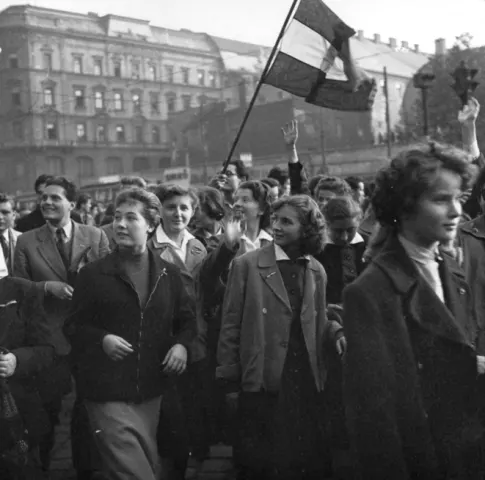
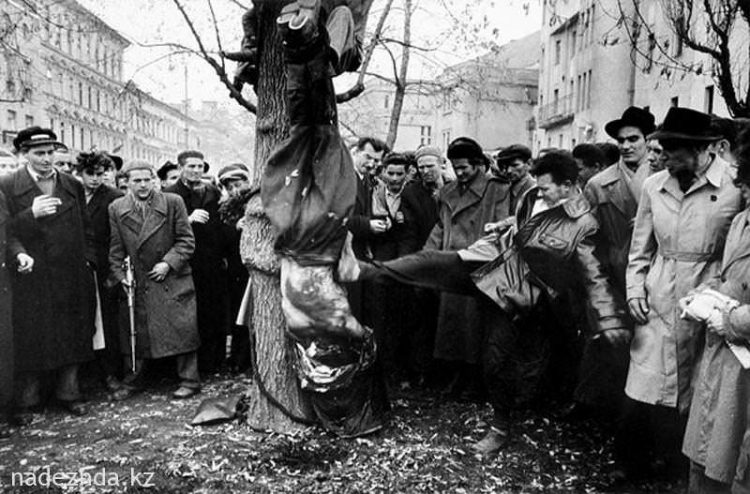
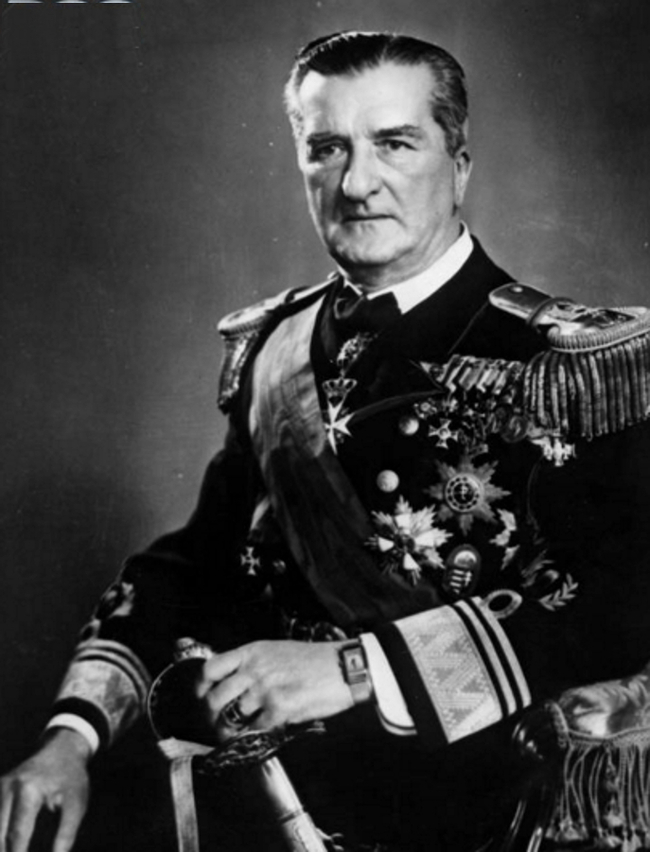
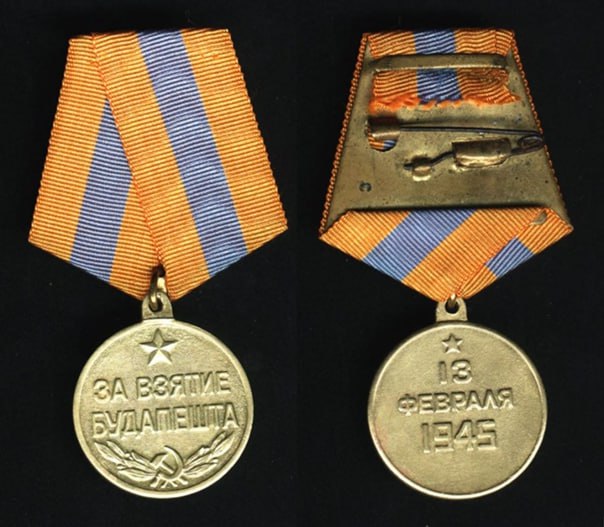
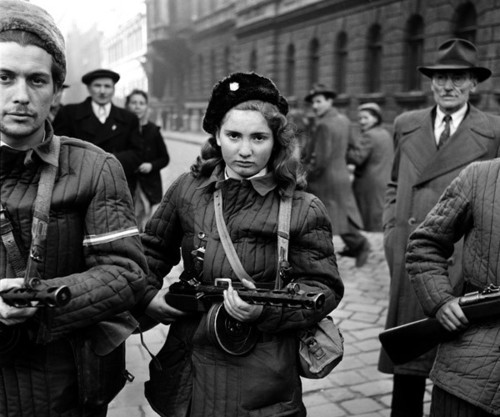
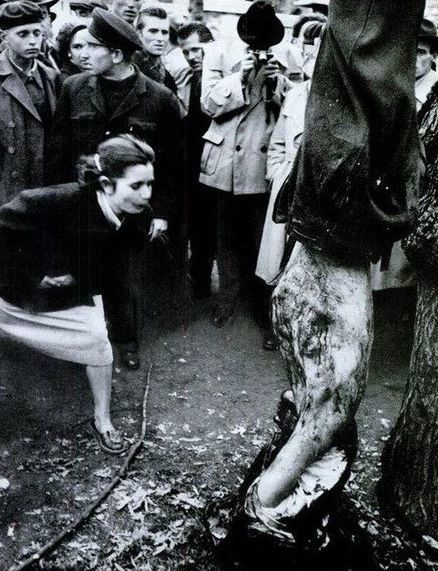
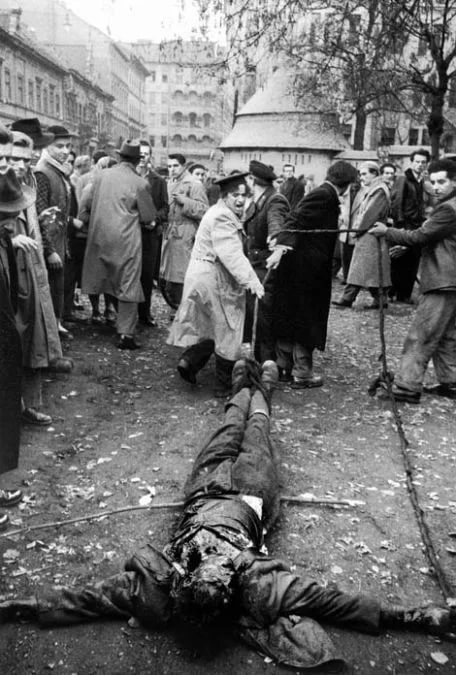
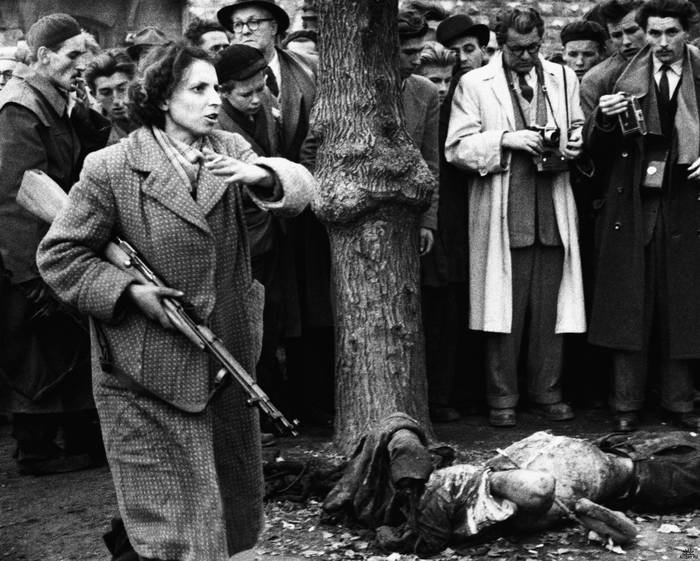

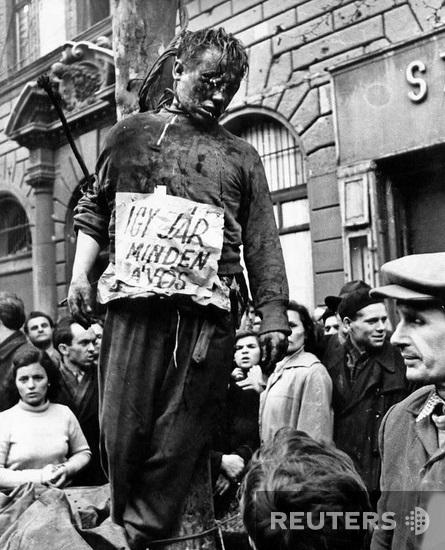
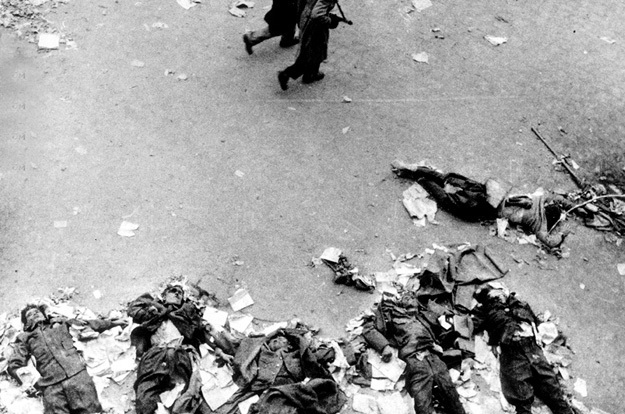
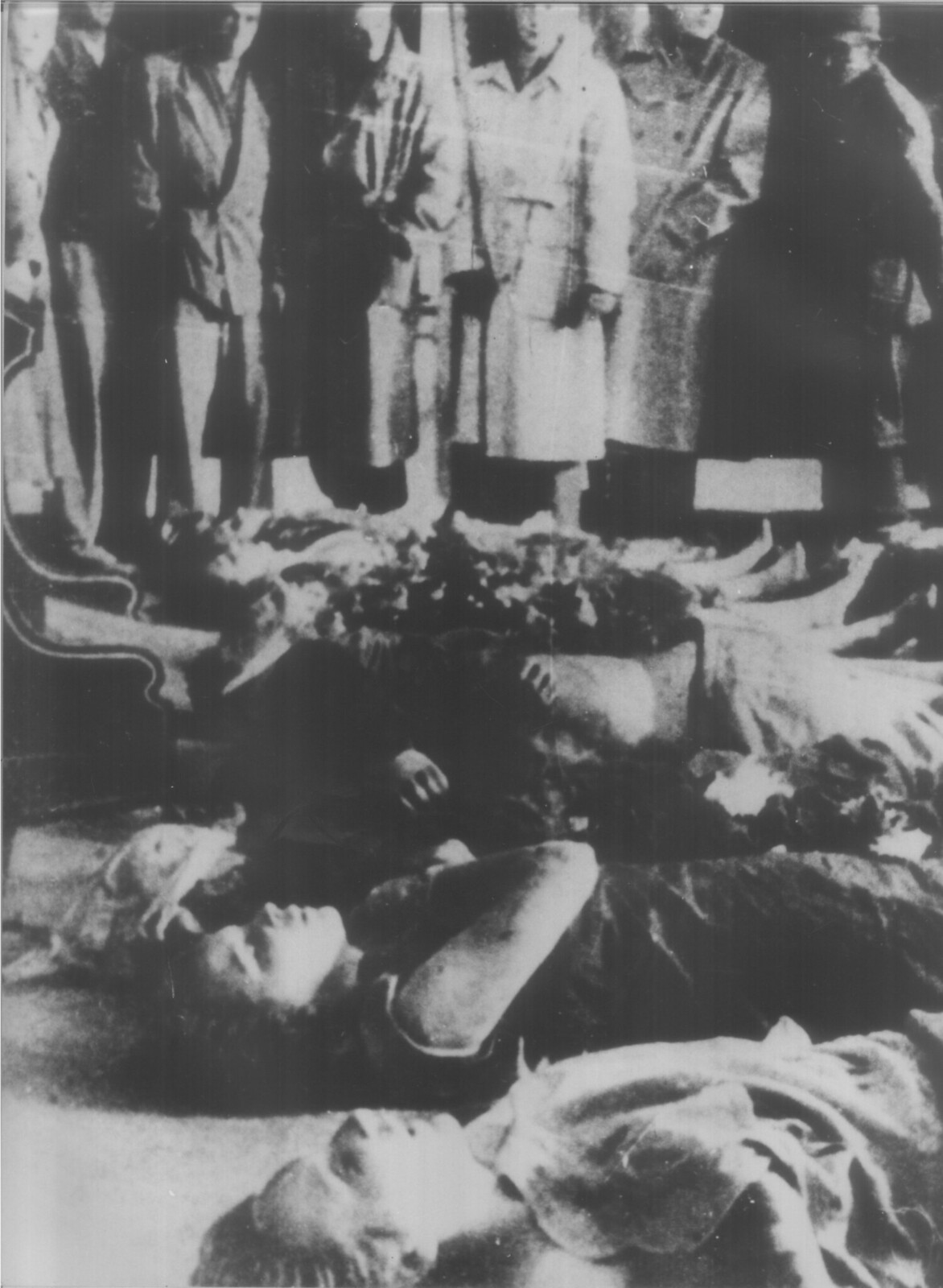
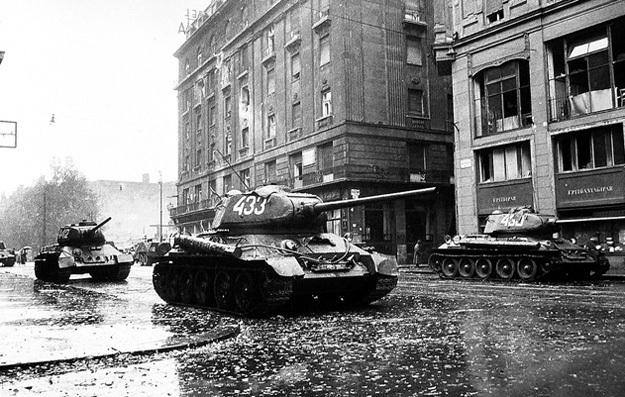


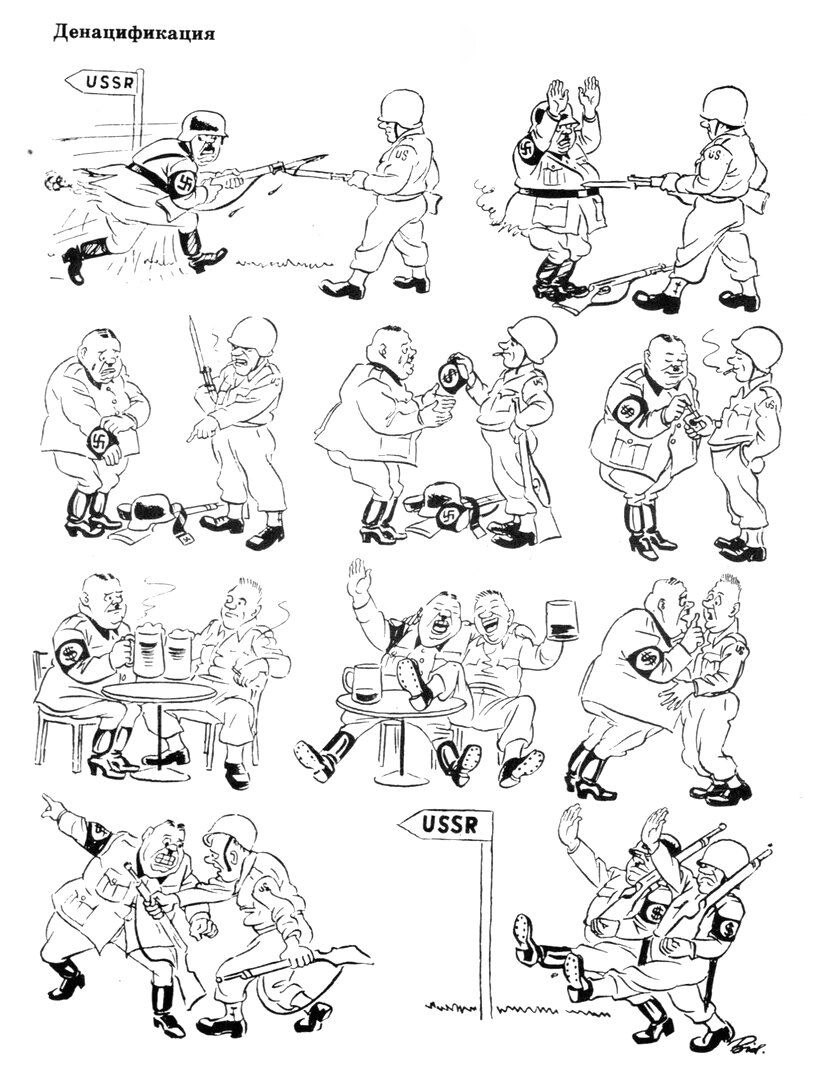
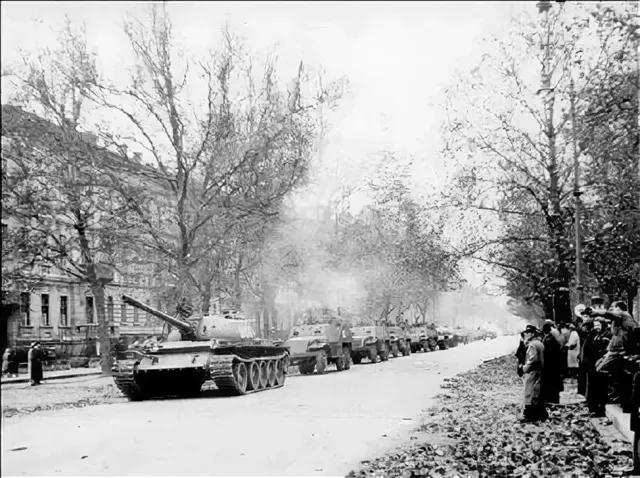

Pingback: “How falsification of history works in our reality”, a lecture by Yegor Yakovlev | Beorn's Beehive